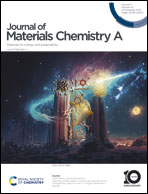Simultaneous upcycling of PET plastic waste and CO2 reduction through Co-electrolysis: a novel approach for integrating CO2 reduction and PET hydrolysate oxidation†
Abstract
Improper handling of polyethylene terephthalate (PET) plastic waste contributes to CO2 emissions during incineration. This study proposes an innovative strategy for tackling PET waste and CO2 emissions simultaneously. Integrating the CO2 electrochemical reduction reaction (CO2RR) with PET hydrolysate oxidation offers a promising avenue. Bismuth oxide carbonate (BOC) loaded on reduced graphene oxide (rGO) and CuCoO loaded on rGO (CuCoO@rGO) were employed for cathodic CO2RR and anodic PET hydrolysate oxidation, respectively, for concurrent production of formate. The anodic CuCoO@rGO catalyst exhibited high electro-activity and a remarkable faradaic efficiency (FE) of 85.7% at 1.5 V vs. RHE. The cathodic BOC@rGO catalyst achieved a FE of 97.4% at −0.8 V vs. RHE, facilitating formate production from CO2RR. Employing this approach in an electrolyzer allowed formic acid production at a low cell voltage of 1.9 V at 10 mA cm−2 with a formate FE of 151.8%. This innovation offers a novel route for PET waste upcycling, CO2 reduction, and environmental sustainability.



 Please wait while we load your content...
Please wait while we load your content...